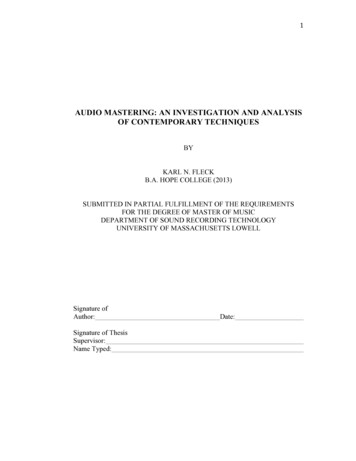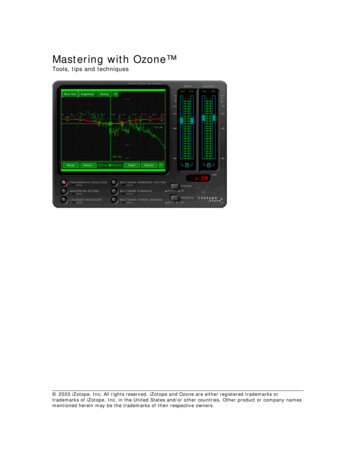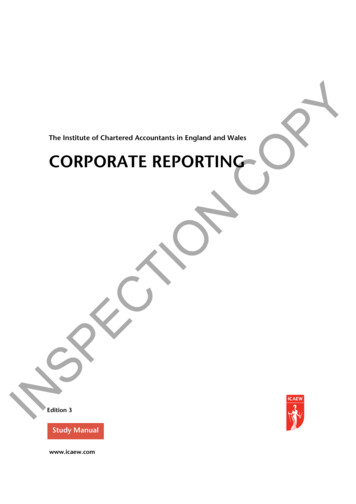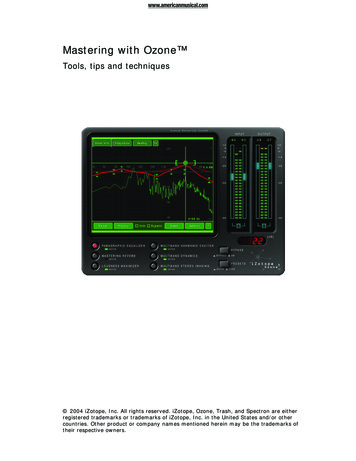
Transcription
FOR LIVE PROGRAM ONLYMastering Reporting of Publicly Traded Partnership andMLP K-1s on Partners' ReturnsWEDNESDAY, DECEMBER 1, 2021, 1:00-2:50 pm EasternIMPORTANT INFORMATION FOR THE LIVE PROGRAMThis program is approved for 2 CPE credit hours. To earn credit you must: Participate in the program on your own computer connection (no sharing) – if you need to registeradditional people, please call customer service at 1-800-926-7926 ext. 1 (or 404-881-1141 ext. 1).Strafford accepts American Express, Visa, MasterCard, Discover. Listen on-line via your computer speakers. Respond to five prompts during the program plus a single verification code. To earn full credit, you must remain connected for the entire program.WHO TO CONTACT DURING THE LIVE PROGRAMFor Additional Registrations:-Call Strafford Customer Service 1-800-926-7926 x1 (or 404-881-1141 x1)For Assistance During the Live Program:-On the web, use the Chat function to send a messageIf you get disconnected during the program, you can simply log in using your original instructions and PIN.
Tips for Optimal QualityFOR LIVE PROGRAM ONLYSound QualityWhen listening via your computer speakers, please note that the qualityof your sound will vary depending on the speed and quality of your internetconnection.If the sound quality is not satisfactory, please e-mail sound@straffordpub.comimmediately so we can address the problem.
Recording our programs is not permitted. However, today's participants canorder a recorded version of this event at a special attendee price. Please callCustomer Service at 800-926-7926 ext.1 or visit Strafford’s websiteat www.straffordpub.com.
Mastering Reporting of Publicly TradedPartnership and MLP K-1s on Partners'ReturnsDecember 1, 2021Jeffrey Clayman, CPA, JD, LLMBrian T. Lovett, CPA, JDTax Senior ManagerPartnerWithum Smith BrownWithum Smith Brownjclayman@withum.comblovett@withum.com
NoticeANY TAX ADVICE IN THIS COMMUNICATION IS NOT INTENDED OR WRITTEN BYTHE SPEAKERS’ FIRMS TO BE USED, AND CANNOT BE USED, BY A CLIENT OR ANYOTHER PERSON OR ENTITY FOR THE PURPOSE OF (i) AVOIDING PENALTIES THATMAY BE IMPOSED ON ANY TAXPAYER OR (ii) PROMOTING, MARKETING ORRECOMMENDING TO ANOTHER PARTY ANY MATTERS ADDRESSED HEREIN.You (and your employees, representatives, or agents) may disclose to any and all persons,without limitation, the tax treatment or tax structure, or both, of any transactiondescribed in the associated materials we provide to you, including, but not limited to,any tax opinions, memoranda, or other tax analyses contained in those materials.The information contained herein is of a general nature and based on authorities that aresubject to change. Applicability of the information to specific situations should bedetermined through consultation with your tax adviser.
Mastering Reporting of Publicly Traded Partnershipsand MLP K-1sBrian T. Lovett, CPA, CGMA, JDJeffrey Clayman, CPA, JD, LLM2020 WithumSmith Brown, PC6
Today’s Agenda Overview of law and regulations Review of K-1 data and footnotes Required reporting, including passive activity rules Gain/loss reporting Special rules for basis Special considerations for oil and gas items2020 WithumSmith Brown, PC7
General Rules IRC Sec. 7704(a) provides that a publicly tradedpartnership (“PTP”) is treated as a corporation forfederal income tax purposes Applies to a partnership if the partnership interestsare: Traded on an established securities market; or Readily tradeable on a secondary market.2020 WithumSmith Brown, PC8
Exception to the General Rule IRC Sec. 7704(c) provides an exception to thisgeneral rule: a PTP is NOT treated as a corporationif the partnership meets a gross income requirementfor the taxable year and all preceding taxable yearsof its existence Gross income requirement outlined in Sec.7704(c)(2) requires that 90% or more of the grossincome of the partnership consists of “qualifyingincome”2020 WithumSmith Brown, PC9
Exception to the General Rule Sec. 7704(d) provides a definition of qualifyingincome: Interest Dividends Real property rents Gain from the sale or disposition of property2020 WithumSmith Brown, PC10
Exception to the General Rule Sec. 7704(d) provides a definition of qualifyingincome (continued): Income and gains from the exploration, development,mining or production, processing, refining, transportationor marketing of any mineral or natural resource Gain from the sale or disposition of a capital asset heldfor production of income described above Income or gain from commodities (including future,forward and options)2020 WithumSmith Brown, PC11
Exception to the General Rule Very typically, the PTP exception noted above isused by master limited partnerships (“MLPs”) in theoil and gas industry These MLPs are structured in such a way as tosatisfy the qualifying income test, resulting inpartnership treatment for income tax purposes2020 WithumSmith Brown, PC12
TCJA Impact on PTPs Under the Tax Cuts and Jobs Act of 2017 (”TCJA”),PTPs received favorable tax treatment Holders of PTP interests are eligible for a 20%deduction from income under new Sec. 199A Under the TCJA, non-corporate taxpayers areallowed this deduction for tax years beginning afterDecember 31, 2017 and before January 1, 20262020 WithumSmith Brown, PC13
TCJA Impact on PTPs Sec. 199A applies to qualified business income froma partnership, S corporation or sole proprietorship Special rules apply for dividends from cooperativesand REITs, as well as income from PTPs Overall, the Sec. 199A deduction is equal to thelesser of: The combined qualified business income amount, or 20% of the excess of taxable income over net capital gains fora given tax year.2020 WithumSmith Brown, PC14
TCJA Impact on PTPs Combined qualified business income amount is anamount equal to: 20% of qualified business income (“QBI”), as limited byW-2 wages and unadjusted basis of property, plus 20% of the aggregate amount of qualified REIT dividendsand qualified PTP income of the taxpayer for the taxableyear.2020 WithumSmith Brown, PC15
TCJA Impact on PTPs Qualified PTP Income is defined within Sec. 199A(Sec. 199A(e)(4)) as the net amount of thetaxpayer’s allocable share of each qualified item ofincome, gain, deduction and loss plus any gainrecognized upon disposition of the interest to theextent such that gain is treated as ordinary incomeunder Sec. 751(a)2020 WithumSmith Brown, PC16
TCJA Impact on PTPs Under Sec. 1909A, QBI is the ordinary trade orbusiness income earned from a sole-proprietorship,S corporation or partnership It does not include any wages earned as anemployee Deduction is available to all non-corporatetaxpayers2020 WithumSmith Brown, PC17
TCJA Impact on PTPs At higher income levels, the deduction becomes subjectto phase-out based on certain thresholds related to theW-2 wages or qualified property of the trade/business Tax year 2020 phase-out thresholds are 326,600 forMFJ return, 163,300 for all others Above this taxable income threshold, the amount of W-2wages and unadjusted basis of property allocated to thepartner/shareholder will be relevant in determining theSec. 199A deduction2020 WithumSmith Brown, PC18
TCJA Impact on PTPs However, note that qualified REIT dividends andqualified PTP income are not subject to the W-2 orbasis limitations Taxpayers with taxable income excess of the thresholdamount will always be able to claim a Sec. 199Adeduction for their allocable share of qualified PTPincome2020 WithumSmith Brown, PC19
TCJA Impact on PTPs Quick Example – A & B are married taxpayers filing ajoint return. A has QBI from an S corporation of 200,000. B has wages of 55,000, and they investedin a PTP that allocated to them income of 20,000.Assuming no deductions, A & B have taxable income forthe tax year of 275,000 before any Sec. 199Adeduction. What is the amount of their Sec. 199Adeduction?2020 WithumSmith Brown, PC20
TCJA Impact on PTPsQualified business incomeamount from S corporation 200,00020% 40,000Qualified business incomeamount from PTP 20,00020% 4,000Total qualified business incomeamountExcess of taxable income overnet capital gainsLesser of qualified businessincome amount or taxableincome limitation 44,000 275,00020% 55,000 44,0002020 WithumSmith Brown, PC21
Overview of Schedule K-1 Things to consider Cover letter Schedule K-1 Pass-through items and distributions Supplemental information Schedule of units purchased and sold2020 WithumSmith Brown, PC22
Overview of Schedule K-1 Cover letter will provide important informationfrom the partnership Deadline to correct any incorrect information Any transactions that would impact reporting, interestsplits, etc. Make sure to review cover letter to ensure thatall necessary information is considered2020 WithumSmith Brown, PC23
Overview of Schedule K-1 – Cover Letter2020 WithumSmith Brown, PC24
Overview of Schedule K-1 The Schedule K-1 will look like those receivedfrom non-PTP partnerships Box for PTP will be checked (Item D) On occasion, you may find a watermark overPart III referring you to supplemental schedules As we will discuss later, passive activity loss rules workdifferently for PTPs and this supplemental informationwill be important in properly reporting the PTP activity2020 WithumSmith Brown, PC25
Overview of Schedule K-1 – Schedule K-12020 WithumSmith Brown, PC26
Overview of Schedule K-1 Many PTPs will provide details in the form ofsupplemental information schedules This information will provide more detail for the amountsshown on Schedule K-1 For a PTP with multiple activities, the supplementalinformation will give allocable information activity byactivity State and other relevant information will also be onsupplemental schedules2020 WithumSmith Brown, PC27
Overview of Schedule K-1 – Supp. Info2020 WithumSmith Brown, PC28
Overview of Schedule K-1- Ownership/Sales Included in the Schedule K-1 package from the PTP,there should be an ownership schedule There should also be a sales schedule showing variousadjustments that will need to be made in the year ofdisposition (more to come on this issue later)2020 WithumSmith Brown, PC29
Overview of Schedule K-12020 WithumSmith Brown, PC30
Overview of Schedule K-12020 WithumSmith Brown, PC31
Passive Activity Rules and PTPs Most investors in PTPs will be considered passiveinvestors, resulting in a potential limitation from claiminglosses allocated from PTPs Passive activity loss rules apply differently for PTPs ascompared to other partnerships2020 WithumSmith Brown, PC33
Passive Activity Rules and PTPs The general rule under Sec. 469 provides that passiveactivity losses may only offset passive activity income Generally, Sec. 469 allows losses from one passiveactivity to offset passive activity income from anotherentity In a tax year in which a passive activity is disposed of,any previously suspended/disallowed losses are freedup and treated as ordinary losses2020 WithumSmith Brown, PC34
Passive Activity Rules and PTPs Code Sec. 469(k) provides special rules for PTPs andprovides that the passive activity limitations apply on aPTP-by-PTP basis Unit holders in multiple PTPs are required to treat eachPTP interest separately for purposes of calculatingpassive activity loss limitations Contrary to the general rule, passive activity losses fromone PTP may not be used to offset passive activityincome from another PTP (or any other passive activity)2020 WithumSmith Brown, PC35
Passive Activity Rules and PTPs There is one exception that will apply – if the entireinterest in the PTP is disposed of in a fully taxabletransaction, losses are deductible in the year ofdisposition and may offset other passive and nonpassive income Unlike non-PTP partnerships, the disposition of anactivity or subsidiary entity will not constitute adisposition that would free up losses – PTP unit holdermust dispose of all units2020 WithumSmith Brown, PC36
Passive Activity Rules and PTPs Passive Activity Example Unit holder goes into tax year 2020 with a prior suspended passiveactivity loss from PTP A of 10,000. During 2020, PTP A allocated 5,000 of income to unit holder. Unit holder also owns PTP B, whichallocates income of 10,000 to unit holder.DESCRIPTION PTP APTP BPre-2020 suspended passive losses( 10,000) 02020 income (Loss) 5,000 10,0002020 net passive income/(loss)( 5,000) 10,000Keep in mind, the net passive loss from PTP A can not be used tooffset the passive activity income from PTP B2020 WithumSmith Brown, PC37
Passive Activity Rules and PTPs Now assume that in 2021, PTP B reports a 10,000 loss allocable tounit holder and PTP A reports income of 10,000 allocable to unitholderDESCRIPTIONPTP APTP BPre-2020 Suspended passive losses( 10,000) 02020 Income/(loss) 5,000 10,0002020 Net passive income/(loss)( 5,000) 10,000Pre-2021 Suspended passive losses( 5,000) 02021 Income/(loss) 10,000( 10,000)2021 Nat passive income/(loss) 5,000( 10,000)2020 WithumSmith Brown, PC38
Passive Activity Rules and PTPs In this case, the net passive income from PTP A isincluded in 2021 taxable income, but the 10,000 lossfrom PTP B is suspended until there is income from or acomplete disposition of PTP B. Example continued In 2023, assume unit holder disposes of her entire interest in PTP Bin a fully taxable transaction. There was no current income or lossallocated to unit holder from either PTP A or PTP B. In this case, thefull amount of the 10,000 in suspended losses attributable to PTPB would be deductible2020 WithumSmith Brown, PC39
Passive Activity Loss Reporting PTP income, gains and losses are not reported on Form8582, which if the form generally used for reconcilingpassive activity income and losses Instead, each unit holder must calculate their ownpassive loss limitations and carry-forwards (on a PTPby-PTP basis) IRS recommends Worksheets 5, 6 and 7 of Form 8582for this purpose2020 WithumSmith Brown, PC40
Passive Activity Loss Reporting Unit holder will include the same types of income andlosses that are included in figuring net income/loss froma non-PTP passive entity Once combining all income and losses, if the result isan overall net gain/income, the result is reported asNONPASSIVE income All component items of income, gain and allowed lossesare shown on the appropriate forms/schedules with anotation “From PTP”2020 WithumSmith Brown, PC41
Passive Activity Loss Reporting Reporting example Taxpayer holds units in PTP A and is allocated income of 8,000 thatwill be reported on Schedule E. In addition, taxpayer has a prioryear suspended Section 1231 loss of 3,500 from PTP A. Once netted together, the overall income/gain is 4,500 which willbe reported as nonpassive income. The 4,500 will be shown incolumn (j) of Schedule E In addition, the 3,000 that is being used to offset the prior perioddisallowed loss is reported on Schedule E, column (g) as passiveincome2020 WithumSmith Brown, PC42
Passive Activity Loss Reporting Reporting example2020 WithumSmith Brown, PC43
Passive Activity Loss Reporting Reporting example On Form 4797, the taxpayer will report the prior year disallowed lossas shown2020 WithumSmith Brown, PC44
Passive Activity Loss Reporting Reporting example 2 Taxpayer holds units in PTP and is allocated loss of 24,000 thatwould be reported on Schedule E. In addition, taxpayer is allocateda Section 1231 gain of 14,000 from the same PTP. Once netted together, the overall loss is 10,000 which will besuspended and carried forward The 14,000 loss that is being used to offset the Section 1231 gainis reported on Schedule E, column (f) as passive loss The Section 1231 gain will be reported on Form 4797 as required Be sure to indicate the amounts are being reported “From PTP”2020 WithumSmith Brown, PC45
Passive Activity Loss Reporting Reporting example 22020 WithumSmith Brown, PC46
Passive Activity Loss Reporting Reporting example 22020 WithumSmith Brown, PC47
Passive Activity Loss Reporting One added complexity with PTPs comes when a PTPincludes multiple activities or subsidiary entities The application of the passive activity rules related to PTPswith multiple activities is unclear, but it is important tomaintain good schedules and support You will want to make sure you have good records in theevent IRS challenge if you offset income/loss from separateactivities of one PTP Check supplemental schedules for separate activity details2020 WithumSmith Brown, PC48
Passive Activity Loss Reporting Form 8582 Instructions seem to indicate that eachactivity of the PTP should be accounted for separately2020 WithumSmith Brown, PC49
Sales of PTP Interests The sale of PTP units will be reported on Form 1099-B forthe tax year of the sale (disposition of a traded security) Unfortunately, given the treatment of PTPs as partnershipsfor income tax purposes, it is not that easy Certain sections of Subchapter K will apply to reclassifyincome from capital gain to ordinary income It will be necessary to review the complete Schedule K-1package received from the PTP to get the necessaryinformation to properly reported the gain/loss2020 WithumSmith Brown, PC50
Sales of PTP Interests Sales worksheet (referenced earlier) will contain thefollowing information needed to properly report thetransaction: Number of units sold Acquisition and disposition dates Adjustments to basis Section 751 ordinary income amount Any AMT adjustments that need to be reported on Form 6251Preparer will need to use sales schedule and informationfrom Form 1099-B to determine ordinary income and capitalgain2020 WithumSmith Brown, PC51
Sales of PTP Interests2020 WithumSmith Brown, PC52
Sales of PTP Interests – Basis Calculations Unit holders are required to calculate their basis using the“average basis” method (sometimes referred to as the“unitary basis” method) The cost for the entire investment is divided by the totalnumber of units owned to arrive at a basis per unit (Rev. Rul.84-53) Specific identification and FIFO are not permitted – counterto the methodology typically employed by investors in publicsecurities2020 WithumSmith Brown, PC53
Sales of PTP Interests – Basis Calculations Basis example Suppose A acquires 600 units in PTP on January 1 for 27/unit. On June 1,A acquired an additional 700 units for 34/unit. A then sold 500 units for 40/unit on December 1. Assuming no adjustments to basis during the taxyear, A’s basis for the sale of 500 units 15,385 and gain is 4,615.Jan. 1June 1TotalUnits sold500Selling price/unit 40Units600700Costs per unit 27 34Total Cost 16,200 23,800Cost per unit 20,0001,300 40,000 30.77 15,3852020 WithumSmith Brown, PC54
Oil and Gas Considerations for PTPs As mentioned earlier, one of the qualifying types of incomethat can be recognized by a PTP relates to income from oiland gas activities Many oil and gas investment vehicles are organized asPTPs, which allow the tax advantages of the oil and gasactivity to pass out to individual investors Two main tax benefits Intangible drilling costs (“IDCs”) Depletion2020 WithumSmith Brown, PC56
Oil and Gas Considerations for PTPs IDCs are costs that Are necessary and incidental to the drilling of wells, and Have no salvage value (Reg. Sec. 1.612-4(a)) Under Sec. 263(c), IDCs are currently deductible and arereported to unit holders on Schedule K-1, Line 13 using Code J If the PTP holds a working interest (as opposed to a mereroyalty interest), they may elect to capitalize IDCs as leaseholdcosts If capitalized, the costs are recovered over time throughdepletion2020 WithumSmith Brown, PC57
Oil and Gas Considerations for PTPs Capitalization is infrequent, it is more common to see thecosts reported on Line 13J as currently deductible If advantageous to the unit holder, the unit holder may makean annual election to capitalize all or a portion of the IDCsand deduct the costs ratably over a 5-year period under Sec.59(e)(4) This election traditionally should be considered when theunit holder is subject to the alternative minimum tax (“AMT”)or has substantial net operating losses2020 WithumSmith Brown, PC58
Oil and Gas Considerations for PTPs If a capitalization election is made, unit holder and/or theirpractitioner will need to pay particular attention to the unitholder’s basis in the assets of the PTP The capitalization will cause the unit holder’s basis withrespect to those assets to differ from the basis on therecords of the PTP On a subsequent disposition of the interest, the informationreported by the PTP relative to the sale transaction will likelybe inaccurate as it relates to the unit holder Recalculation of gain/loss on the disposal will be necessary2020 WithumSmith Brown, PC59
Oil and Gas Considerations for PTPs Example – Annual Deduction of IDCs Assume A owns an interest in PTP. In tax year 2020, PTP incurred 600,000 ofIDCs, of which 60,000 was allocated to A on Schedule K-1, Line 13j. A expectsto be subject to the AMT and decided to make an election to capitalize 50,000of IDCs shown on Schedule K-1, Line 13j. As a result, A will deduct 20,000 ofthe IDCs on her 2020 Form 1040, calculated as follows:DescriptionIDCs per Sch. K-1, Line 13jLess: Capitalized amountCalculationTotal 60,000( 50,000) 10,000Capitalized IDCsYears of amortization 50,0005 10,000Total 2020 deduction 20,0002020 WithumSmith Brown, PC60
Oil and Gas Considerations for PTPs Example – Sale of PTP PropertyPer PTPShare of property basis – 1/1/2020Less: 2020 IDCShare of property basis – 12/31/2020Selling price for property – 2021Less basis remaining (from above)Gain to be reported on disposalPer Unit holder 60,000 60,000( 60,000)( 20,000) 0 40,000 120,000 120,000 0( 40,000) 120,000 80,0002020 WithumSmith Brown, PC61
Oil and Gas Considerations for PTPs Example – Sale of PTP Property If PTP sells the property in 2021 for 1,200,000, PTP will providedata to the unit holders on Schedule K-1, Line 11, Code F related tothe disposition that may assume that all unitholders elected todeduct the IDCs allocated in 2020. However, A will still have a basisof 40,000 in her share of the IDCs ( 60,000 in IDCs allocated less 20,000 in deduction claimed on the 2020 return). Assuming that isallocated 120,000 of the proceeds of the sale of the property, thegain calculation will look as follows:2020 WithumSmith Brown, PC62
Oil and Gas Considerations for PTPs Absent an election under Sec. 59(e), deduction of IDCscreates a tax preference item to the extent that the unitholder’s “excess intangible drilling costs” exceed 65% of thenet income from the property (Sec. 57(a)(2)) “Excess intangible drilling costs” are the amount by whichthe IDCs exceed the amount which would have beendeducted had the costs been capitalized and amortized over120 months This amount is reported on Schedule K-1, Line 17, Code F2020 WithumSmith Brown, PC63
Oil and Gas Considerations for PTPs The AMT impact is complicated by the fact that there is a limitedexception to the AMT rule for independent producers that extendsto individual investors in partnerships that are independentproducers (Sec. 57(a)(2)(E)) Independent producers generally include drillers andexploration/production companies This exception should operate to allow most individual unitholdersto avoid an adverse AMT impact Exception can not result in a reduction to the AMTI by more than40% of AMTI computed without considering the exemption2020 WithumSmith Brown, PC64
Oil and Gas Considerations for PTPs As a result of the exemption, two calculations are required: First, AMTI must be computes as thought the full amount ofthe excess IDCs are included as a preference item Second, the resulting AMTI is multiplied by 40%, whichprovides the maximum amount by which the AMTI can bereduced by the exemption2020 WithumSmith Brown, PC65
Oil and Gas Considerations for PTPs Example – AMT Calculations Assume Unitholder receives a Schedule K-1 showing 200,000 of IDCs on a well that started producing on April 1,2020. Gross income from the property was reported to be 90,000, lease operating expenses were 35,000. Beforeconsidering the tax preference created by the IDC, Unitholderhas AMTI of 275,000. In order to determine the impact onUnitholder’s AMT, we need to complete the two calculations.First, we must determine the tentative tax preference itemrelated to the excess IDCs.2020 WithumSmith Brown, PC66
Oil and Gas Considerations for PTPs Example – AMT CalculationsIDCs allocated on Schedule K-1 200,000Less amortization (9/120 months)( 15,000)Excess IDCs 185,000Gross income from property 90,000Less: operating expenses( 35,000)Less: amortization( 15,000)Net operating income65% of net income from propertyTentative tax preference item 40,00065% 26,000 159,0002020 WithumSmith Brown, PC67
Oil and Gas Considerations for PTPs Example – AMT Calculations Once we determine that the tentative tax preference item is 159,000, we must determine how much of the exemptionunder Sec. 57(a)(2)(E) we can claim to reduce the AMTI afterincluding the tax preference and find the resulting AMTI to bereported for 20202020 WithumSmith Brown, PC68
Oil and Gas Considerations for PTPs Example – AMT CalculationsAMTI before tax preferenceA 225,000Add tentative tax preference item 159,000AMTI after preference 384,000Maximum reduction percentage40%Maximum reduction of IDC preference 153,600Tentative IDC preference 159,000Maximum reduction of IDC preferenceRemaining tax preference itemUnitholder’s AMTI (Sum of A)( 153,600)A 5,400 230,4002020 WithumSmith Brown, PC69
Oil and Gas Considerations for PTPs Depletion is another issue that may impact PTP unit holders Allows an owner/operator to account for the reduction of a naturalresource product’s reserves Oil and gas partnerships report depletion annually on each unitholders Schedule K-1 in proportion with the unit holders“economic interest” The actual amount of the deduction is determined at theunitholder level (Sec. 613A(c)(7)(D) – no depletion is claimed atthe PTP level (Sec. 703(a)(2)(F))2020 WithumSmith Brown, PC70
Oil and Gas Considerations for PTPs Unit holders may elect to utilize either percentage depletion or costdepletion and may deduct the greater of the two calculated numbers(Reg. Sec. 1.611-1(a)) Comparison is completed on a property-by-property basis Percentage depletion if calculated based on the percentage noted inSec. 613(b)(2) (currently 15% for oil/gas), but is limited to 100% of the“taxable income from the property” in the case of oil/gas (50% for othertypes of property) Cost depletion is generally computed by the PTP and begins by dividingthe leasehold costs by the estimated recoverable reserves (cost perunit), then multiplying by the number of units sold during the year (Reg.Sec. 1.611-2(a))2020 WithumSmith Brown, PC71
Oil and Gas Considerations for PTPs Since depletion deduction is calculated at the unit holder level, the PTPmust allocate to the unit holders their ratable share of each item that ispart of the depletion calculation (Reg. Sec. 1.613A-3(e)) Schedule K-1 should include a schedule reflecting each unit holder’sshare of cost depletion and percentage depletion on a property-byproperty basis Schedule K-1 will also reflect each unit holder’s share of gross incomeand net income from each property Under Sec. 613A(d)(1), the percentage depletion deduction cannotexceed 65% of the unit holder’s taxable income for the year, withoutregard to the depletion allowance or any NOL carryovers (disalloweddepletion is carried forward)2020 WithumSmith Brown, PC72
Oil and Gas Considerations for PTPs Example – Depletion deduction Unitholder has 2020 taxable income of 300,000 without considering a depletiondeduction from investment in PTP. PTP has three properties and Unitholder receivedthe following information from PTP Prop AProp BProp CPercentage depletion 180,000 270,000 150,000Cost depletion 120,000 0 30,000Tentative depletion ded. 180,000 270,000 150,000Total 600,000Based on this information, the total tentative depletion deduction is 600,0002020 WithumSmith Brown, PC73
Oil and Gas Considerations for PTPs Example – Depletion deduction However, under Sec. 613A(d)(1), the percentage depletion deduction can not bemore than 65% of Unitholder’s taxable income, resulting in a limitation of 195,000( 300,000 of taxable income time 65%). The reduction ( 600,000 - 195,000 405,000) needs to be allocated in proportion to tentative percentage depletionTentative % depletionReduction% depletion as limitedProp AProp BProp CTotal 180,000 270,000 150,000 600,000( 121,500)( 182,250)( 101,250)( 405,000) 58,500 87,750 48,750 195,0002020 WithumSmith Brown, PC74
Oil and Gas Considerations for PTPs Example – Depletion deduction The reduced percentage depletion by property is then compared to the cost depletionby property to determine the deduction on a property-by-property basis:Prop A% depletion as limited Prop BProp C 58,500 87,750 48,750Cost depletion 120,000 0 30,000Tentative depletion ded. 120,000 87,750 48,750Total 256,500Since cost depletion on Property A exceeds the limited percentage depletion, thetaxable income limitation is then reallocated to Property B and C to determinepercentage depletion2020 WithumSmith Brown, PC75
Oil and Gas Considerations for PTPs Example – Depletion deduction Reallocation of limitation ( 420,000 - 195,000 225,000):Prop ATentative % depletionReduction% depletion as limited Prop BProp CTotal 270,000 150,000 600,000( 144,643)( 80,357)( 225,000) 125,357 69,643 195,000After all calculations, the Unitholder’s depletion deduction will be as follows:Prop A% depletion as limitedProp B 125,357Cost depletion 120,000Depletion deduction 120,000Prop CTotal 69,643 30,000 125,357 69,643 315,0002020 WithumSmith Brown, PC76
Oil and Gas Consider
Dec 01, 2021 · The general rule under Sec. 469 provides that passive activity losses may only offset passive activity income Generally, Sec. 469 allows losses from one passive activity to offset passive activity income from another entity In a tax year in which a passive activity is disposed










